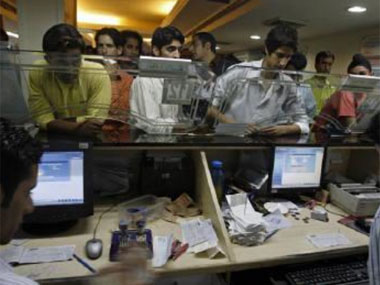Banking stocks are once again witnessing pressure as a slowdown in economy has raised the possibility of higher defaults. Higher cost of capital and foreign-exchange volatility are likely to result in a further rise in non-performing loans. Though some analysts have been bearish on the sector, others have maintained a bullish stance, saying valuation of the sector is attractive to initiate investments.
[caption id=“attachment_155060” align=“alignleft” width=“380” caption=“AFP”]  [/caption]
What can perhaps change the view of bullish analysts is the rising cost of credit default swaps (CDS). Credit swaps pay the buyer face value in exchange for the underlying securities or the cash equivalent should a nation or company fail to adhere to its debt agreement.
A Bloomberg report says that costs to protect bonds of Indian banks against default are rising at the fastest pace among Asian lenders. Five year CDS of Mumbai-based ICICI Bank has jumped 76 basis points in the past month to 471 basis points, the biggest advance in the region. On the other hand swaps of SBI have hit a two-year high of 397 basis points.
Meanwhile, further delays in clearances by the state government to infrastructure projects has increased the risk of default and bad loans for banks which have reportedly sanctioned a large number of loans for large projects. A Business Standard report today stated that in “The eastern region, five infrastructure projects, with a total investment of Rs 16,686 crore, are awaiting various approvals.”
The banking sector is facing unprecedented liquidity issues. With the advance tax date nearing by mid-December, further liquidity is expected to be sucked out of the system. Indian banks have borrowed each day from the central bank since April to meet fund shortages. This rampant borrowing is likely to have an impact on the banks’ margins in the current quarterly numbers.
Impact Shorts
More ShortsBanks are borrowing at an average of Rs 74,500 crore per day from the central bank this quarter as compared to an average of Rs 43,800 crore in the previous quarter. As a result overnight bank rates have moved up by 315 basis points to 8.65 percent.
Rating agency Moody’s downgraded the outlook for India’s banking system last month to “negative,” citing a domestic economic slowdown and the surge in borrowing costs which will boost bad loans.
The rating agency even downgraded SBI, the country’s largest lender, last month as the bank’s capital ratio was below the government’s 8 percent target for state-run lenders. In an interview with Bloomberg on Monday, Pradip Choudari, Chairman, State Bank of India, said the bank “plans to cancel untapped credit lines and change how some loans are classified to bolster its cushion against losses pending,” while it waits for the government to inject more funds.
The BSE Bankex had underperformed the market over the past one month until 12 December 2011, sliding 7.79 percent compared with the Sensex’s 7.69 percent decline. The index had also underperformed the market in past one quarter, sliding 8.38 percent as against 3.83 percent fall in the Sensex.


)

)
)
)
)
)
)
)
)



